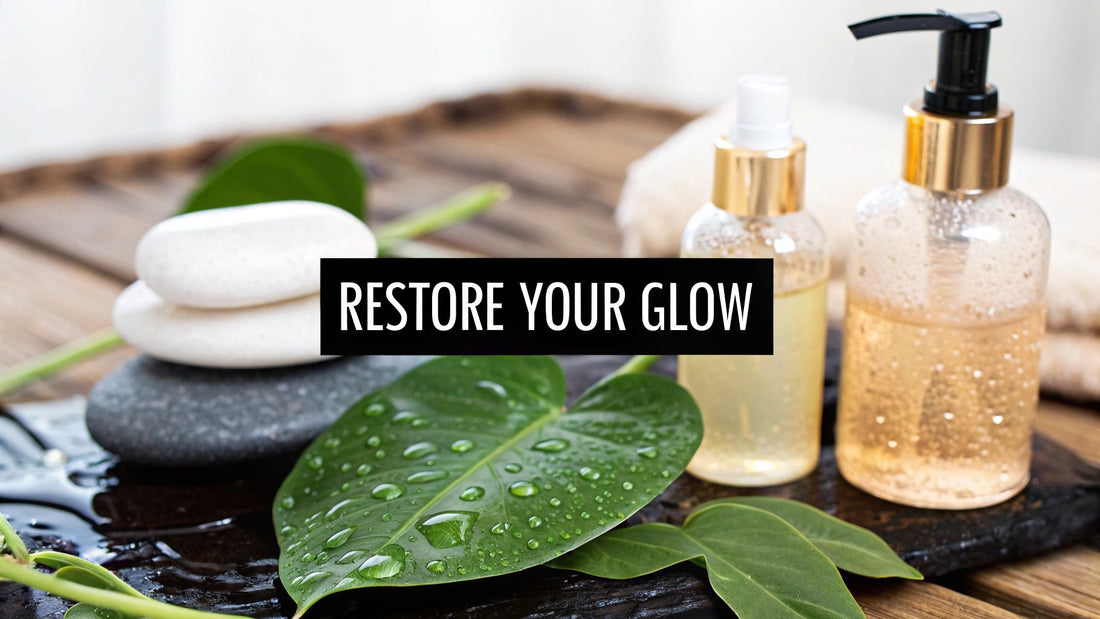
How to Treat Dehydrated Skin and Restore Your Glow
Share
Before you can start treating dehydrated skin, you have to be absolutely sure that's what you're dealing with. It's an easy mistake to make, but it's a crucial one. Your skin isn't necessarily craving more oil; it's crying out for water. Once you learn to spot the difference between a dehydrated condition and a genuinely dry skin type, you can finally build a routine that brings back that plump, glowing look we all want.
Is Your Skin Thirsty or Just Dry?
Figuring out what your skin truly needs can feel like solving a puzzle. Many people I've worked with think their skin is dry when it’s actually just incredibly thirsty. This confusion is common, but telling them apart is the key to getting results.
Think of it this way: dry skin is a skin type you're born with. It's characterised by producing less natural oil (sebum). On the other hand, dehydrated skin is a temporary condition where your skin is short on water.
This means literally anyone—whether you have oily, combination, or even dry skin—can experience dehydration. You might have a shiny T-zone but still feel that classic tightness across your cheeks. That's a telltale sign your skin needs hydration, not more oil control.
To make this clearer, here’s a quick breakdown of how they differ.
Dry Skin vs Dehydrated Skin: A Quick Comparison
| Characteristic | Dry Skin | Dehydrated Skin |
|---|---|---|
| Root Cause | Lacks natural oils (sebum) | Lacks water (hydration) |
| Feel | Often rough, flaky, or scaly | Feels tight, taut, and sometimes sensitive |
| Appearance | Small pores, may look dull | Lacklustre, shows fine, papery lines |
| Nature | A permanent skin type | A temporary, treatable condition |
| Can Affect | Primarily those with a genetic predisposition | Any skin type, including oily and combination |
Recognising these differences is the first real step towards giving your skin what it's actually asking for.
The Telltale Signs of Dehydrated Skin
So, how can you be sure your skin is suffering from a lack of water? Dehydration can be sneaky, often masquerading as other issues like premature ageing or general sensitivity.
Here are the key signs I tell my clients to watch for:
- A Feeling of Tightness: Your skin feels uncomfortably taut, almost like it's a size too small, especially right after cleansing.
- Sudden Fine Lines: You start noticing new, fine, almost crepey lines on your forehead or cheeks that weren't there before. These are dehydration lines, not true wrinkles.
- A Dull, Lacklustre Complexion: Your skin loses its natural radiance. It just looks flat or tired, no matter how much you rest.
- Patchy Makeup: Does your foundation or concealer cling to certain spots, look uneven, or seem to vanish by midday? That's a classic sign.
- Redness and Irritation: When your skin lacks water, its moisture barrier gets compromised. This makes it much more vulnerable to things like pollution and weather, leading to sensitivity.
If this sounds familiar, you're not alone. Skin conditions are incredibly common in the UK, with around 60% of the population having dealt with one. According to the British Skin Foundation, a staggering 70% of people with skin conditions say it negatively affects their confidence. This just goes to show how important it is to find a real, working solution.
My Key Takeaway: Dehydrated skin is a temporary state caused by water loss and can happen to anyone. The fix involves two things: putting water back in and repairing the skin's barrier to stop it from escaping again.
How Dehydration Shows Up at Different Ages
While anyone can get dehydrated skin, how often it happens can change as we get older. Over time, our skin's natural ability to hold onto moisture starts to decline.
This chart shows just how common dehydrated skin is across different age groups, based on what people report as their main skin concern.
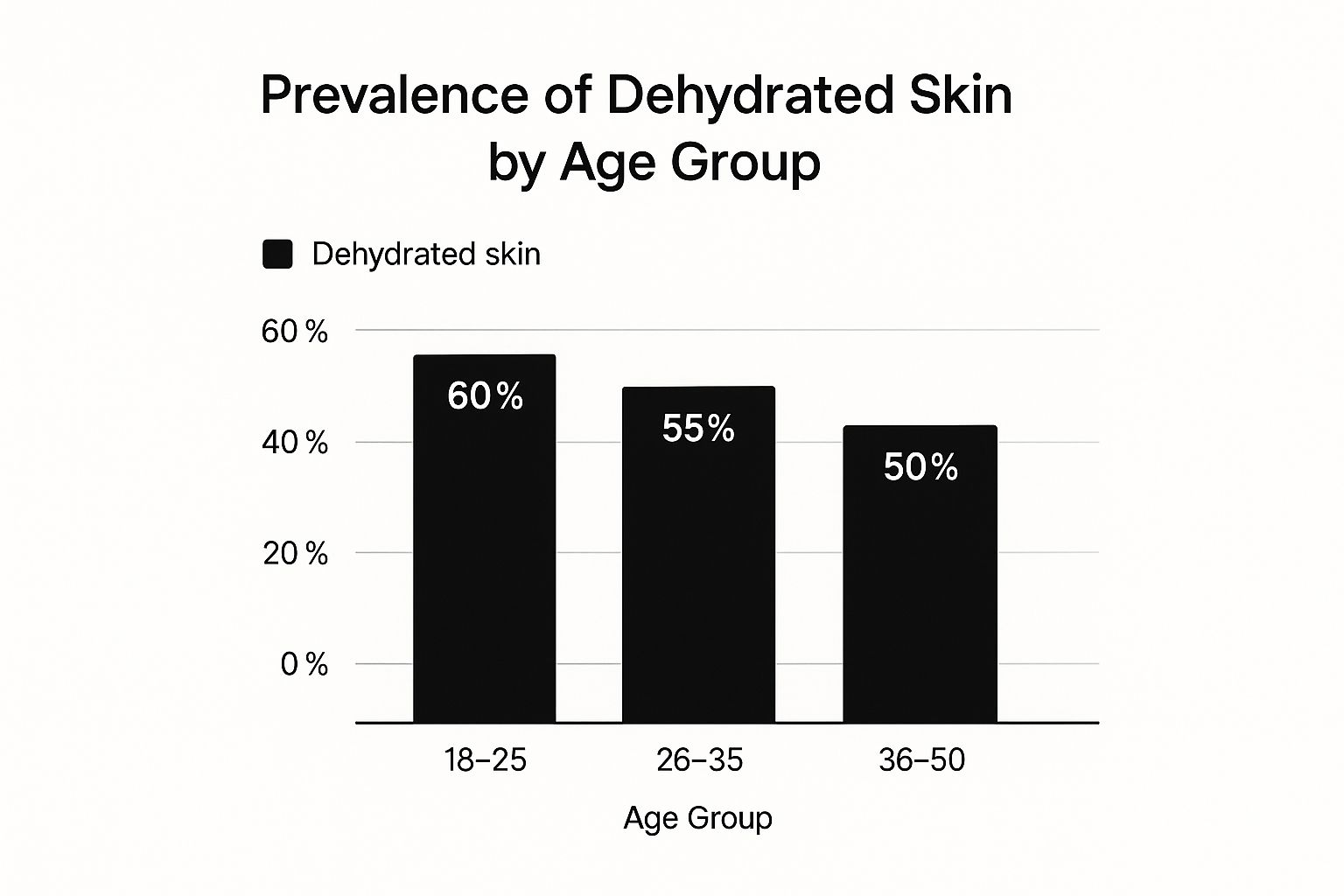
As you can see, while younger people report more issues with dehydration, it's still a major concern for those well into their 50s.
Ultimately, getting to grips with the difference between dry and dehydrated skin is the most critical part of learning how to treat dehydrated skin properly. One needs oil; the other needs water. Once you’ve nailed that distinction, you can confidently start picking the right ingredients and building a routine that gives your skin exactly what it needs to get back to being balanced, plump, and radiant.
The Best Skincare Products for Dehydrated Skin
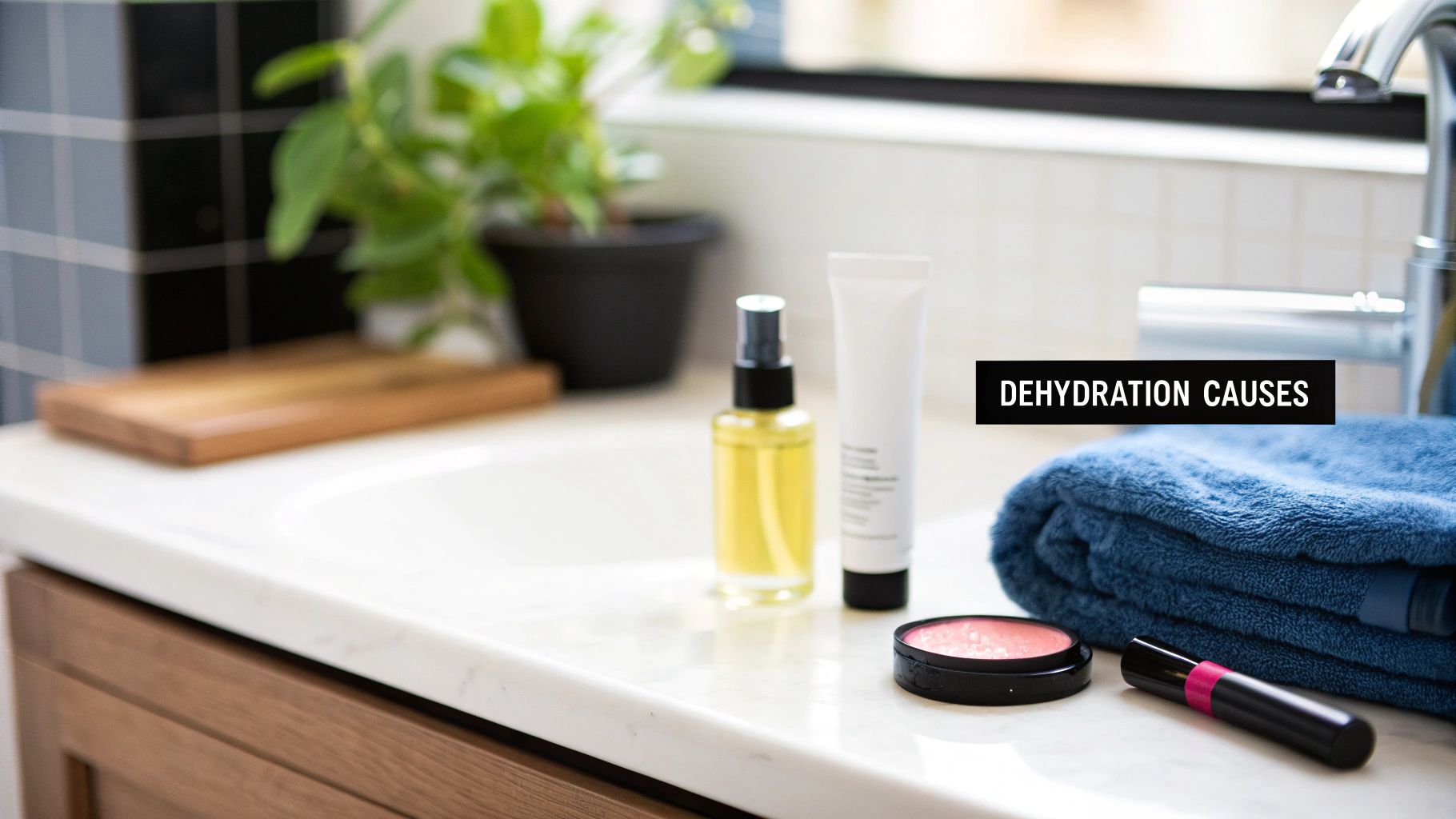
When you're trying to figure out how to treat dehydrated skin, the sheer number of products out there can feel overwhelming. I’ve seen clients get completely bogged down trying to decipher complicated labels.
The good news? It’s simpler than you think. You’re really looking for products that do two key things: pull water into your skin, and then, crucially, lock it in place. Let’s cut through the marketing jargon and focus on the types of products that genuinely make a difference.
Hydrating Serums with Humectants
Think of humectants as tiny moisture magnets. Their main job is to draw water into the top layer of your skin, pulling it from the deeper layers and even from the air around you. A serum is the best way to deliver these ingredients, as it's a concentrated formula designed to sink in deeply.
Look for serums with these heavy hitters:
- Hyaluronic Acid (HA): This is the most well-known for a reason. It’s a powerhouse hydrator capable of holding up to 1,000 times its own weight in water. Nothing quite beats it for instantly softening those fine, crepey lines that dehydration causes.
- Glycerin: A true unsung hero in skincare. Glycerin is incredibly effective at not just attracting water but also helping to fortify your skin's natural moisture barrier. It’s gentle, reliable, and a staple in so many well-formulated products.
- Polyglutamic Acid (PGA): A newer ingredient that’s been getting a lot of attention, PGA can reportedly hold even more moisture than hyaluronic acid. It creates a breathable film on the skin, which is fantastic for preventing water from simply evaporating away.
Applying a humectant-rich serum is a brilliant first step after cleansing, giving your skin a massive drink of water before you move on to moisturising.
Expert Tip: I always tell my clients to apply their hyaluronic acid serums to damp skin. This gives the HA molecules extra water to grab onto, supercharging their hydrating effect. If you apply it to dry skin, it can sometimes pull moisture from deeper within, which is the opposite of what you want.
Barrier-Repairing Moisturisers
Once you’ve drawn all that lovely moisture in, the next step is to make sure it stays put. This is where a good moisturiser comes into play. It's the key to repairing your skin’s barrier and creating a protective seal.
A weak or damaged skin barrier is often the real culprit behind chronic dehydration. It has tiny cracks that allow water to escape in a process known as trans-epidermal water loss (TEWL).
To rebuild that barrier, look for moisturisers with these ingredients:
- Ceramides: These lipids are the real building blocks of your skin, making up roughly 50% of your skin barrier. I like to describe them as the "mortar" holding your skin cells together. Adding them back into your routine helps patch up the cracks, keeping moisture in and irritants out. A healthy barrier is fundamental, which is why hydration is the secret to youthful skin.
- Squalane: This is a wonderfully lightweight and non-greasy oil that’s brilliant for almost every skin type, even those who are oily or prone to breakouts. It closely mimics your skin’s own natural oils, so it moisturises and softens beautifully without the risk of clogging pores.
- Niacinamide (Vitamin B3): A true multi-tasking superstar. Not only has it been proven to boost your skin’s own ceramide production, but it also helps calm redness and improve your skin’s overall resilience. It’s a fantastic supporting ingredient in any dehydration-focused routine.
Finding a product that blends these different types of ingredients is the smartest strategy. A great moisturiser doesn't just give you a temporary moisture boost; it helps your skin become better at hydrating itself in the long run.
Building Your Morning Hydration and Protection Routine
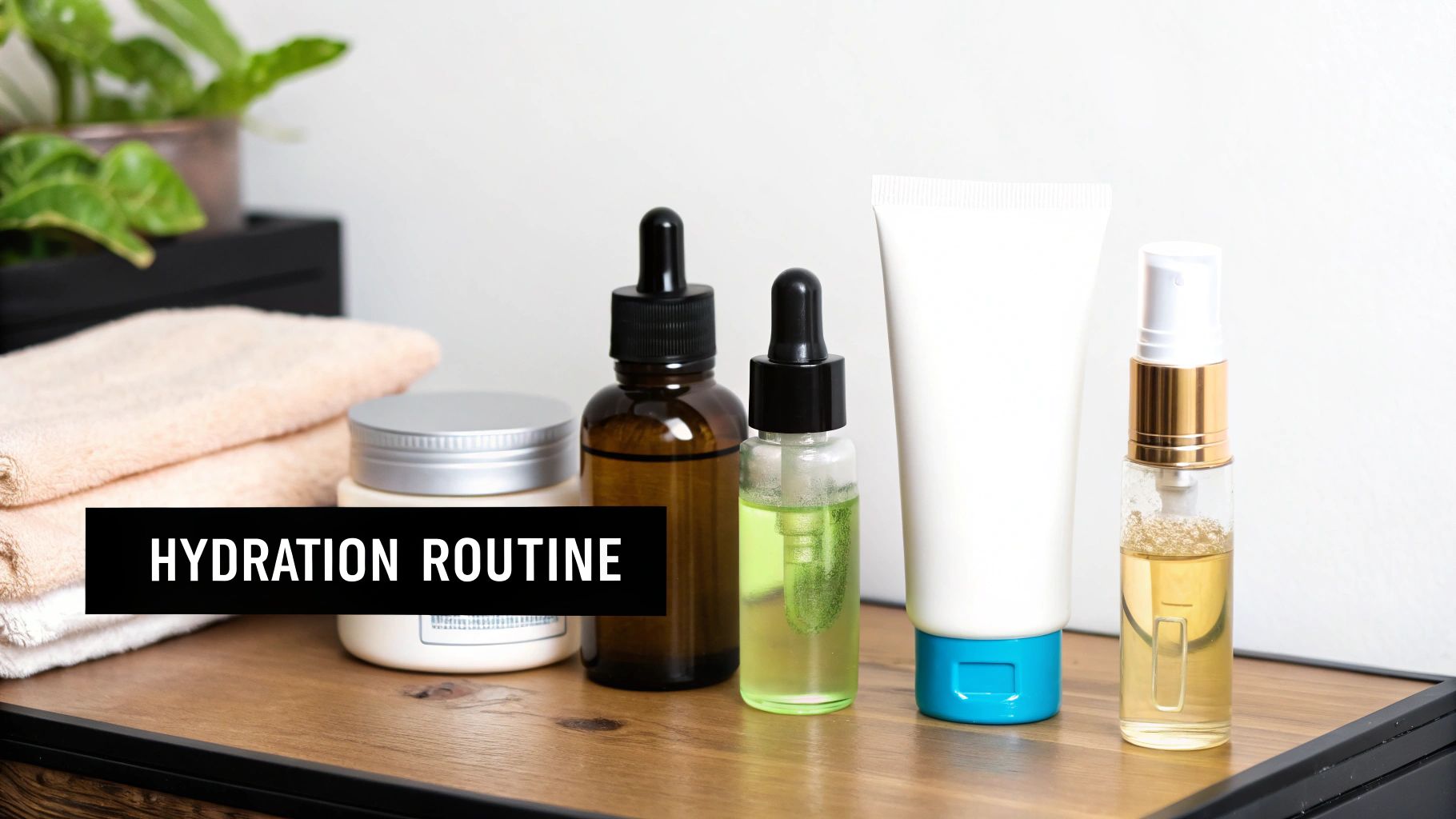
Your morning skincare routine is all about setting your skin up for success. It needs to do two crucial things: replenish the moisture your skin inevitably lost overnight and build a protective shield against everything the day throws at it, from UV rays to pollution.
Forget those complicated, 10-step routines you see all over social media. When you're figuring out how to treat dehydrated skin, keeping things simple and consistent is what truly gets results. A solid morning routine boils down to a gentle cleanse, smart hydration, and absolute protection.
Step 1: Gentle Cleanser
The very first thing you do in the morning can either help your skin's moisture barrier or start to tear it down. Dehydrated skin is already fragile, so a harsh, stripping cleanser is its worst enemy.
Reach for a gentle, non-foaming, or cream-based cleanser. These formulas are brilliant because they clean away any overnight grime without messing with your skin's natural acid mantle. Your face should feel soft and comfortable afterwards, never tight or squeaky. That "squeaky clean" feeling is actually a red flag that you've stripped away essential oils and water.
Step 2: Hydrating Toner or Essence
This is where the real magic happens. The secret to getting deep, lasting hydration is to layer your products correctly, always applying them to damp skin. So, after cleansing, resist the urge to vigorously towel-dry your face.
Leaving your skin slightly damp creates the perfect environment for your hydrating products. It gives ingredients like hyaluronic acid something to hold onto, pulling that surface water deep into your skin for maximum effect.
Straight after cleansing, while your skin is still damp, pat on a hydrating toner or essence. Look for formulas packed with glycerin, panthenol, or other soothing humectants. This step is like priming a canvas; it makes your skin ready to drink up whatever you apply next.
Step 3: Targeted Hydrating Serum
Now it’s time for your powerhouse hydrator. A good hyaluronic acid serum will sink in beautifully, locking in all the moisture from your toner and leaving your skin feeling instantly softer and bouncier.
I always tell my clients to think of this step like watering a plant. A splash of water on dry, compacted soil just runs off. But if the soil is already slightly damp, it soaks up the water far more effectively. Your skin works the same way.
Step 4: Barrier-Friendly Moisturiser
You’ve just given your skin a huge drink of water; now you need to seal it all in. If you skip this, all that lovely hydration can just evaporate off your skin's surface—a process we call trans-epidermal water loss (TEWL).
A great moisturiser for dehydrated skin will contain both humectants (to hydrate) and ingredients that repair your skin's barrier. This is where ceramides are absolute superstars. Think of them as the natural "mortar" that holds your skin cells together. A moisturiser rich in ceramides helps patch up any cracks in your moisture barrier, preventing water from escaping and providing a comforting, protective layer that doesn't feel heavy.
If you're interested in building out a full-circle regimen, you can find more tips in our guide to the ultimate skincare routine for radiant, healthy skin.
Step 5: Essential Sunscreen
This is, without a doubt, the most critical step of any morning routine, especially when your skin is dehydrated. Sun exposure is a primary cause of a damaged moisture barrier. UV rays break down your skin's supportive structures, leading to more water loss and inflammation.
A broad-spectrum sunscreen with at least SPF 30 is completely non-negotiable. It shields your skin from further damage, which gives it a chance to focus its energy on repairing and rehydrating itself. Thankfully, modern sunscreens are so elegant and lightweight—many even include hydrating ingredients—that they feel like a pleasure to apply. Find one your skin loves and commit to using it every single day, no matter the weather.
Your Nighttime Repair and Rehydration Ritual
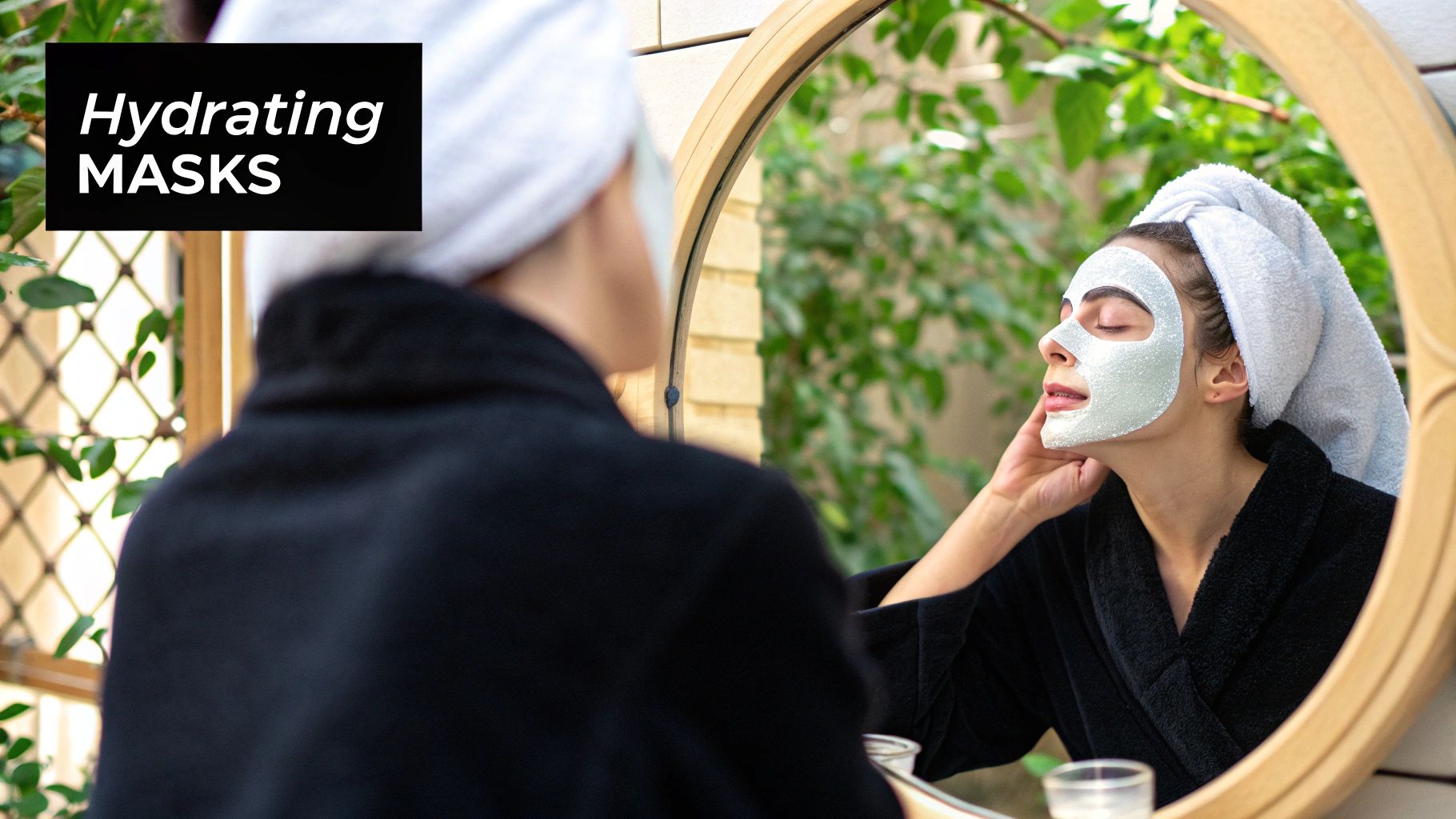
While you're asleep, your skin is wide awake and hard at work. This is its prime time for repair, when it diligently regenerates cells and recovers from the day's stressors. Your nighttime routine is your opportunity to give it a helping hand, focusing on deep rehydration and barrier support.
Mastering how to treat dehydrated skin really comes down to creating a smart evening ritual. The goal is simple: cleanse thoroughly, prep the skin for what's next, and then lock in all that goodness to prevent moisture from escaping overnight. Get this right, and you’ll wake up to skin that feels noticeably plumper, calmer, and more resilient.
Step 1: The Double Cleanse
Before you can even think about applying those lovely hydrating treatments, you need a perfectly clean slate. A quick once-over with a cleanser often isn't enough to tackle the build-up from a long day—we're talking makeup, sunscreen, city grime, and natural oils.
This is where the double cleanse becomes a game-changer. It's a two-step method that gets your skin truly clean without stripping it of its essential moisture.
- First, an oil-based cleanser: Start with a cleansing oil or balm. These are fantastic for dissolving stubborn, oil-based products like makeup and SPF. Massage it onto dry skin, then splash on a little water to emulsify it into a milky liquid before rinsing it all away.
- Next, a water-based cleanser: Follow up with your gentle, hydrating cleanser (the same one from your morning routine works perfectly). This step removes any lingering residue and washes away water-based impurities like sweat and dirt.
This one-two punch leaves your skin perfectly prepped, allowing your serums and moisturisers to penetrate much more effectively.
Step 2: Gentle Chemical Exfoliant (2-3 times/week)
Dehydrated skin often has a layer of dead cells sitting on the surface, which can lead to a dull, lacklustre appearance and block your products from doing their job. Gentle exfoliation is the answer, but it has to be done carefully to avoid upsetting your skin's already fragile barrier.
Forget harsh physical scrubs. Instead, reach for a mild chemical exfoliant that contains Lactic Acid. As an Alpha Hydroxy Acid (AHA), lactic acid is a brilliant choice for dehydrated skin. Its molecules are larger, so it works on the surface and is less likely to cause irritation. Even better, it's also a humectant, meaning it helps hydrate the skin while it exfoliates.
Crucial Tip: Resist the urge to exfoliate every night. Over-exfoliation is a fast-track to a damaged moisture barrier and more dehydration. Limit yourself to using a gentle chemical exfoliant just two or three times per week, and always at night.
This simple step clears the path, allowing all your hydrating ingredients to sink in deeply where they're needed most.
Step 3: Layer and Seal for Overnight Hydration
With your skin cleansed and ready, it’s time to layer on the moisture. Your evening routine is the perfect moment to bring out slightly richer, more nourishing formulas than you might use during the day.
Start by applying your hydrating serums—like those packed with hyaluronic or polyglutamic acid—onto damp skin, just like in the morning. This delivers an immediate and much-needed drink of water.
Now for the final, most critical step: sealing it all in. Your nighttime moisturiser should be all about barrier repair and preventing trans-epidermal water loss (TEWL)—the natural process of water evaporating from your skin as you sleep. Look for creams rich in ingredients like ceramides, squalane, and nourishing butters.
For an extra treat, consider swapping your regular moisturiser for a sleeping mask two to three times a week. These products are specifically designed to create a light, breathable film over the skin, locking in all the products layered underneath and providing intense, sustained hydration until you wake up. The result? A visibly dewier, more comfortable complexion come morning.
Lifestyle Habits That Deeply Hydrate Your Skin
While a well-planned skincare routine is non-negotiable, what you do throughout the day often has an even bigger impact. Truly getting to grips with how to treat dehydrated skin means looking beyond your bathroom cabinet. It’s about building lifestyle choices that support hydration from the inside out.
Think about it this way: your topical products work hard to repair the skin's barrier and stop water from escaping. But your daily habits are what provide that water in the first place. If your body's internal reservoir is running low, your skin is one of the first places you'll see the effects.
Hydration Really Does Start from Within
It might sound glaringly obvious, but drinking enough water is the cornerstone of hydrated skin. Every single cell in your body, including your skin, needs water to function properly. When you're internally dehydrated, your body smartly diverts water away from the skin to support your vital organs, leaving your complexion looking flat and feeling tight.
And it's not just anecdotal. Research backs this up. Here in the UK, a common starting point for treating dehydrated skin is simply boosting internal hydration. Studies have shown that a total daily water intake over 3,200 mL can positively influence the skin's moisture levels and even its biomechanical properties, making it feel bouncier and more plump. For a deeper dive into professional options, Eden Skin Clinic has some great insights on treatments available in the UK.
A Tip from Experience: Can't stand plain water? I get it. Try infusing it with cucumber and mint, or slices of lemon and orange. Herbal teas count towards your daily total, too. The real trick is consistent sipping throughout the day, not chugging a litre in one go.
Eat Your Water (and Your Fats!)
Your diet is another incredibly powerful tool. You can literally eat your way to better hydration by choosing foods that are naturally full of water and nutrients that strengthen the skin barrier.
Try to weave more of these into your meals:
- Water-Rich Fruits & Veg: Things like cucumber, celery, watermelon, and strawberries are over 90% water. They’re a brilliant—and delicious—way to top up your hydration levels.
- Healthy Fats: This is a big one. Fats are essential for building strong cell membranes and a resilient skin barrier. Foods rich in omega-3 and omega-6 fatty acids help your skin hold onto moisture all by itself. Think oily fish like salmon and mackerel, plus avocados, walnuts, and flaxseeds.
A diet packed with these nutrients gives your skin the raw materials it needs to repair itself and lock in moisture. When your barrier is strong, less water escapes, and your skin feels healthier and more comfortable.
What to Cut Back On for Better Hydration
Just as some habits help, others can actively work against you. Being mindful of these common culprits can make a surprising difference to your skin’s moisture levels.
- Too Much Alcohol: Alcohol is a diuretic, which is a fancy way of saying it makes you lose more water than you take in. This leads to system-wide dehydration that quickly shows up on your face as dullness and more obvious fine lines.
- Excessive Caffeine: Much like alcohol, caffeine has a mild diuretic effect. Your morning coffee is probably fine, but if you're relying on several caffeinated drinks to get through the day, you could be undermining your hydration efforts.
- Salty Foods: A diet high in sodium can pull water out of your cells, leaving both your body and your skin feeling parched.
This isn’t about total deprivation, but about finding a healthier balance. If you have a coffee or an alcoholic drink, just make a point of drinking an extra glass of water to offset the effects. Improving your diet and hydration can also do wonders for how your skin feels to the touch; you can learn more in our guide on how to improve skin texture.
Considering Professional In-Clinic Treatments
For those times when your skin needs a serious intervention, professional treatments can deliver an immediate and noticeable boost. While your at-home routine is crucial for long-term health, these treatments can give your skin a real head start on its recovery.
Many clinics across the UK offer specialised services designed to flood the skin with moisture. They use professional-grade technology and potent formulas to deliver hydration far deeper than any topical cream can on its own.
A couple of popular options include:
- Hydrafacials: This is a multi-step facial that cleanses, exfoliates, extracts impurities, and then infuses the skin with intensive, super-hydrating serums. It’s like hitting the reset button for a thirsty complexion.
- Mesotherapy: This technique involves tiny injections of vitamins, enzymes, and hyaluronic acid directly into the middle layer of the skin to nourish and rejuvenate from the inside out.
Going for a professional treatment can be a fantastic way to supercharge your results, complementing all the hard work you’re putting in with your daily routine and lifestyle.
Common Questions About Dehydrated Skin
Even when you have a great routine mapped out, you’re bound to hit a few snags or have questions pop up along the way. When you're trying to figure out how to treat dehydrated skin, you might find yourself troubleshooting specific issues or just wondering how long it will take to see all your hard work pay off.
Let’s walk through some of the most common queries I hear from people. These answers should help you fine-tune your approach, manage your expectations, and navigate any bumps in the road on your journey back to a plump, glowing complexion.
How Do I Treat Dehydration if I Also Have Oily Skin?
This is easily one of the most frequent—and frustrating—dilemmas. When you have skin that’s producing excess oil but still feels tight, flaky, or looks dull, it’s a classic sign of dehydration. Your skin is essentially overproducing sebum to compensate for a severe lack of water.
The trick is to give your skin the water it’s crying out for without slathering on heavy, pore-clogging oils. Your goal is to find balance, not to strip it dry.
- Lean into lightweight hydrators. Your new best friends are oil-free serums and gel-based moisturisers. Look for formulas packed with humectants like hyaluronic acid and glycerin. They pull water into the skin without adding weight.
- Never, ever skip moisturiser. I know it’s tempting when your skin feels greasy, but this is counterproductive. A good lightweight, non-comedogenic moisturiser actually signals to your skin that it’s hydrated enough, which can help regulate that frantic oil production over time.
- Ditch harsh, stripping products. Step away from aggressive foaming cleansers with sulphates or toners loaded with alcohol. These will only damage your moisture barrier further and send your oil glands into complete overdrive.
By focusing purely on hydration, you’ll often find that your skin naturally becomes less oily as it rebalances itself.
What Skincare Ingredients Should I Avoid?
Knowing what not to use is just as important as knowing what to use. When your skin's moisture barrier is compromised, it becomes far more sensitive and reactive to ingredients that might not normally cause an issue.
Steering clear of certain additives can prevent further irritation and water loss, giving your skin the best possible chance to heal.
A few key ingredients to put on pause are:
- Denatured Alcohol: Often hiding in ingredients lists as 'Alcohol Denat.', 'SD Alcohol', or 'Isopropyl Alcohol'. This type is incredibly drying and can wreak havoc on your skin barrier. It’s completely different from beneficial fatty alcohols like 'Cetearyl Alcohol', which are actually wonderful emollients.
- Harsh Sulphates: Things like Sodium Lauryl Sulphate (SLS) and Sodium Laureth Sulphate (SLES) give cleansers that satisfying lather, but they are far too stripping for a fragile barrier.
- Witch Hazel: While some people swear by it, many common witch hazel formulas are distilled with a high concentration of alcohol, making them far too astringent for thirsty, dehydrated skin.
- Fragrance (Natural and Synthetic): Both can be major sources of irritation for compromised skin. To be safe, look for products clearly labelled 'fragrance-free'.
Cutting these out, even just for a while, can make a world of difference to how quickly your skin recovers.
A Quick Reminder: Always scan the full ingredients list. I’ve seen plenty of products marketed as "hydrating" that still contain drying alcohols or irritating fragrances. Becoming a savvy label-reader is a real skincare superpower.
How Long Will It Take to See a Difference?
Ah, the million-dollar question. The honest answer is: it really depends. The timeline for seeing results hinges on things like how long your skin has been dehydrated, the current state of your skin barrier, and, most importantly, how consistent you are with your new routine.
That said, you can generally expect to see changes in stages.
- Within a few days: You should start to feel a difference. The first positive sign is often that your skin feels less tight and tight after cleansing and more comfortable during the day.
- Within 2-4 weeks: This is when you'll likely start to see visible improvements. Your skin should look plumper, and those fine, papery dehydration lines will become less obvious. You might also notice your complexion starting to regain some of its natural radiance.
- After a month or more: With consistent care, your skin barrier will be much stronger and more resilient. The real win here is that your skin will be much better at holding onto moisture all by itself, making it less prone to dehydration in the future.
Patience and consistency are truly your most powerful tools. Stick with your gentle, hydrating routine, and your skin will thank you for it.
Ready to give your thirsty skin the targeted care it deserves? At P-Eleven, we offer a curated selection of science-backed, natural skincare solutions designed to restore hydration and bring back your glow. Explore our collections and find your perfect routine.


